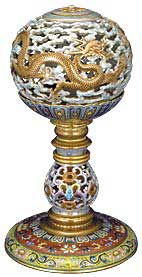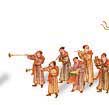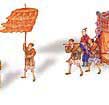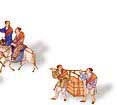Page 4 of 6, dVINE Blues, March 1999
The
dragon in Chinese Art
The
National Palace Museum in Taipei, Taiwan includes art representing 5,000
years of China.
The Museum granted Lee & Lee Communications the sole license to
produce a Treasure the Treasures Series which brings these incredible
works of art to the world. The Series includes:
A Treasure-house of Chinese Art, A City of Cathay, The Dragon in Chinese
Art, Gems of China's Cultural Relics, The National Palace Museum Experience,
 and Glories of Chinese Calligraphy.
and Glories of Chinese Calligraphy.
This evaluation is about The Dragon in Chinese Art, Volume3,
which began distribution in late summer,1998.
I have been a fan of the dragon for many years and was quite excited
to learn about the Dragon in Chinese Art CD-ROM. To me and to
many Westerners, the dragon is a fire breathing symbol of the Emperor.
However, to the Chinese, the dragon is associated with rainfall (not
fire) and the Emperor. The dragon graces plates, bowls, cups, tea pots,
miscellaneous containers, water vessels, vases, pictures, plaques, mirrors,
paperweights, bells, robes, combs,
building columns and numerous other things.
A modern day use of the dragon and other works of art from the National
Palace Museumis business cards. The employees of
Lee & Lee Communications have different Chinese works of art on
their business cards. Thet are gorgeous cards.
The Dragon in Chinese Art package contains a 31 page Guidebook
which is a work of art. It contains three sections (Dragons in
Chinese Folklore, A Dragon Family Tree and Operation Manual).
Throughout the Guidebook are pictures of some of the priceless dragon
art pieces in the National Palace Museum collection.
When you begin the Dragon in Chinese Art CD-ROM, you are greeted with
a severn minute audio Introduction to the ddragon. You nca listen to
the entire introduction(which will repeat) or click on Antiquities,
Dragon Types, Chronology, Back, or Exit on the dragon pillar on the
left side of the screen The audio Introduction describes how the dragon
is ubiquitoous in Chinese art and society. Perhaps you have had the
opportunity to experience the dragon dance, the Chinese new year celebration
or other ceremonies featuring the dragon. The Introduction states that
Bruce Lee's
(the martial arts expert) Chinese name is Little Dragon Lee.
When you open the Antiquities, Dragon, or Chronology section you are
greeted with music by
Tsai Shen Music Productions, The music plays in the background as you
move the mouse over
the objects and get info. The sections are interlinked so moving around
the program is quite easy. Some objects contain descriptive text and
others contain a video. You can jump between
categories by clicking on the icon in the wave area at the bottom of
the screen. In each of these sections use the magnifying glass icon
to enlarge an object of interest. If you move the mouse
to the edge of the screen, it will automatically scroll horizontally
or vertically.
Click on Antiquities and you find a fan shape with a choice of nine
categories (Costume,
Lacquer, Carvings, Jades, Enamels, Studio Accessories, Paintings, Porcelain,
or Bronze).





There are 126 dragon decor exhibits in the section which rage from
the Neolithic Age to the middle/late Ch'ing Dynasty. For example, click
on Costume and you see several objects
(cap, Belt, hairpins, perfume pouch). Click on one of the hairpins and
read the descriptive
textof the dragons and gems on the hairpin. Magnify the hairpin to better
see the detail.
Click on Dragon and you see a globe depicting the ten Chinese dragon
categories
(K'uei, coiled, interlaced, striding, cloud, serpent, seated, ascending,
rampant, and the dragon fish).
The difference in the dragons might be the number of talons, the position
of the head or tail, or many other things. As youmove the mouse over
each dragon, the name of that type of dragon appears. You can learn
about he dragon's evolution, growth in popularity, how it became associated
with the Emperor, and more in this section. For example, click on the
seated dragon and it is magnified.
A video program describes how it became the symbol of the Empleror and
that only the Emperor could adorn his clothes, throne, bed, etc. with
the dragon. The seated dragon is also referred to
as the imperial dragon or the orthodox dragon.
Click on Chronology and a vessel depiction chronological periods appears
from 1600 BC-1900 AC. There are fourteen chronological periods represented
in this section. Click on the Shang Dynasty (1600-1100 BC) and you learn
that the K'uei dragon was popular at this time. The legend is that
the K'uei was a man eating beast with a single horn. Click on another
object on the screen.
For example, P'an with a coiled dragon decor and learn that this vessel
was used to receive
the water from washing hands before sacrifices.
 The Dragon in Chinese Art is one of the most impressive art
The Dragon in Chinese Art is one of the most impressive art
software programs I have seen. It is a great program to look at
when you have some quiet time, want to learn more about the dragon,
want to escape your busy day, etc. It would be awesome
to see the collection at the National Palace Museum in Taipei.
My Godparents have seen it and said it is incredible.
The year of the dragon occurs every twelve years and is considered
a wonderful time for Chinese children to be born. To commemorate the
year of the Dragon in 2000, Lee & Lee Communications is going to
be offering a new DVD-ROM in September.
--
Lee Schwab